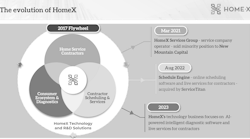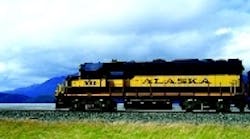Heating the Land of the Midnight Sun
The state is geographically very large, but from a population viewpoint, it's very small. Alaska is, in essence, a small town. Reputation and relationships are everything.
By Michael S. Weil
Since completion, the Alaska Railroad has played a central role in Alaska's growth, providing a means for communities to settle and flourish along the railbelt, supplying the Fairbanks gold fields, helping to build the Alaska Highway, supporting the war effort, and hauling pipe and supplies for the construction of the Trans-Alaska Pipeline System. Headquartered in Anchorage, the clean blue and yellow rail cars are a rolling landmark of Alaskan progress.
Also headquartered in Anchorage is another company that is a landmark of progress — a landmark in the Alaskan mechanical systems business.
Klebs Heating is a contracting firm that employs approximately 85 people and serves both the construction and service/replacement markets in both the commercial and residential sectors. In 2006 the company is well on its way to achieving $12 million in gross sales, tripling its size in just three years.
Its president, Gary Klebs, founded the company in 1986 as a two-person operation based in a company specialized in commercial sheet metal ventilation and exhaust ducting. Today, Klebs specializes in the installation and servicing of commercial and residential heating, air conditioning, and ventilation systems using hydronic systems and air technology.
Though its beginnings was strictly in metal, within the past six or seven years, there has been significant growth in the use of hydronic systems in commercial applications across Alaska. According to Klebs, that growth led him to diversify the company. Klebs attributes this growth to a number of causes:
- Alaska is well known for its environmental policies and the rugged individualism of its people. New technologies are quickly grasped by commercial consumers, to help them manage their energy use as well as the productivity of their employees.
- The state has tremendous financial resources generated from the oil pipeline that was built in the 1980s, and potential resources from the proposed gas pipeline in the works right now.
- The military is a giant customer in Alaska.
"We always wanted to be the total mechanical contractor in control," Klebs says, "and we learned in our early days that contractors who did everything (forced air, hydronics, controls, service, design, new construction) were in control of their projects and their destinies."
As a commercial non-union contractor working in a highly unionized environment, Klebs has all the incentive he needs to "stay on his toes."
"They (the unions) do us a favor by keeping us alert. They are excellent competitors — forcing us to review everything we do and how we run the business. But the key to our success is our employees."
General manager Eden Larson concurs. Larson, whose varied background includes working for the Associated Builders and Contractors (ABC), says it's difficult to find and hire technically competent people with experience in the HVACR and hydronics fields; as well as people who also have good attitudes and a strong work ethic.
"So we hire people for their attitudes and train them in the skills," she says.
"We're very invested with employee development and training. NATE certification is very important to us on the residential side, and we will certify all our commercial technicians as soon as the NATE commercial tests are available."
Klebs explains that their investment in employees is one in permanent employment. "We don't buy into traditional construction management models where you hire seasonally. We want our people working for us all year long."
In addition to technical development, Klebs also maintains a professional development program for managers and supervisors. Gary Klebs says this commitment to their people is one of the company's biggest differentiators.
Because of this training, the company can be flexible — adopting new technologies and skillsets as needed. One of those adoptions was the move into the commercial hydronics business. In fact, he says the hydronics business was a natural outgrowth of Klebs' commercial plumbing division.
Gary's son Mike Klebs is the plumbing department manager and holds their plumbing licenses. "In Alaska," he says, "commercial hydronics applications just make a lot of sense. It's cold in Anchorage for a long time. The first snow falls around Halloween and stays on the ground until Easter. We have long, dark winters and to have ambient warmth coming from the floor is not only comfortable, but comforting as well," he says.
The sale may be easy, but the application often isn't, especially if it requires running pipe underground. Says Mike Klebs, "Permafrost is a big issue here. For companies who've never had to deal with it, permafrost can be a huge barrier to being successful. You must account for it in your load calculations and you must use the right materials to do the job right. People who take shortcuts, well, they just fail."
And that's because Alaska isn't the typical place to work. Says Eden Larson, "relationships and reputation are everything here. The state is geographically very large, but from a population viewpoint, it's very small. Alaska is, in essence, a small town.
"If you take shortcuts and don't do what's in the customer's best interest, you absolutely won't be successful here."
And that's why Klebs Mechanical strives to do things right the first time, in a first class manner. It's this approach that helps them land projects not only all over the state, but around the world. The map on the first page highlights several commercial projects done over the last several years, and shows the extended territory that Klebs' field people cover.
Of all the work done in 2006, some of the most interesting projects were close to home. The Anchorage Zoo, for example, was building a new educational facility. Klebs engineered a hydro-air system with some radiant heating to meet the clients' needs. This includes an insulated run of radiant heat to separate the admissions building from the rest of the facility.
This system used a number of Versa-Flo variable speed pumps, combined with several three-speed Grundfos SuperBrutes circulators, and two sealed-combustion direct vent 65,000 BTU Bradford-White water heaters with seismic strapping.
Seismic strapping? Indeed. Alaska is one of the world's, most seismically active regions. The "Good Friday Earthquake" of 1964 struck South-central Alaska with a magnitude of 9.2, killing 131 people. Most of them were drowned by the tsunamis that tore apart the towns of Valdez and Chenega. Building codes were adopted soon thereafter, requiring seismic strapping on mechanical systems.
To demonstrate their prowess with hydronic technology, when Klebs built a new headquarters building this year, it was 100% hydronically heated. The first floor is totally heated using a radiant system, and the second floor employs a state-of-the-art hydro-air system that uses gas-packaged units with hot water coil in the duct for early morning warm-up.
The building is interfaced with a web-based building automation system. Packaged units on the roof provide constant tempered heat at 65F in the winter and 55F in the summer. Plus a snow-melt system that is part of the first floor radiant system keeps the front of the building free of ice and snow.
Klebs' building is a showcase for commercial hydronics system technology, as well as their prowess in sheet metal fabrication, web-based controls, piping, plumbing, and more.
From the moment you step into the lobby, the pride of the employees, the cleanliness, and the overall "feel" of the place tells you that providing comfort in the land of the midnight sun is job one at Klebs Mechanical.













